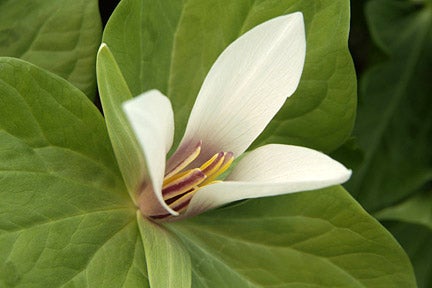
Quick facts
Common name - Wake robin
Latin name - Trillium
Group - Perennial
Flowering time - Spring
Planting time - Late summer
Height and spread - Up to 50cm (20in) by 50cm (20in)
Aspect - Part shade
Hardiness - Fully hardy
Difficulty - Moderate
Cultivation notes
Trilliums grow from a rhizome, emerging in March or April, flowering, setting seed and dying down from July to October. Most trilliums are fully hardy.
Trilliums are perfect planted between shrubs that provide both shade and shelter from the wind. Alternately, a shady border against a wall or fence is a good location. Trilliums prefer a neutral to acid soil, but they will grow successfully in a good fertile soil that is rich in organic matter and does not dry out. In dry and sandy soils, line the bed with polythene to retain moisture but put in several puncture holes to allow excess moisture to drain away.
Although trilliums are moisture lovers, they will not tolerate waterlogging. They will not thrive on heavy, wet clay soils. Planting in raised beds are a solution. Another is to dig out the clay to a spades depth and fill with a mixture of loam, garden , well rotted manure and composted bulked up with . Mound the material so it is at least 10cm (4in) above the surrounding soil level. This allows plants to root deeply but avoids them sitting in conditions over winter.
Trilliums should be planted about 7-10cm (2½-4in) deep. The best time for planting is late summer as it gives the time to establish good root systems before the following growing season.
Keep well watered during dry weather in spring and early summer. Apply an annual of well decayed organic matter in early spring. A light application of a balanced fertiliser in late winter is also beneficial.
Containers
Trilliums do not really thrive in containers as they prefer a moist, rich garden soil. But you can try them in pots of sandy loam, such as John Innes No. 3 with added gritty sand.
Propagation
Trilliums are not difficult plants to grow but they are slow to increase.
Division
Established clumps can be lifted and divided as the foliage dies back. Ensure each piece of rhizome has at least one and some roots. can be encouraged by scoring. To do this, scrape back the soil after flowering and score around the base of the terminal bud with a sharp knife. By the following year this will often result in several lateral buds or offsets that can be detached and grown on.
A variation on the technique is to remove the terminal bud entirely with about 2.5cm (1in) of rhizome and replant. New lateral buds will form on the rhizome remaining in the ground.
Seed
Sow seed as soon as it is ripe in pots of John Innes and place in a in shade.
Trillium seed has double . Sown immediately after harvest, the seed will germinate the following spring, after a period of chilling, to produce a root. Another cycle of warmth and chilling is then necessary for a shoot to emerge the second year. After a further two or three years the characteristic three leaves form.
Flowering may occur a year or two later. With very few exceptions trillium seed will not tolerate dry storage and old seed is usually dead.
Cultivar Selection
Some good trilliums for the garden include;
Trillium erectum AGM: In spring this trillium produces dainty nodding flowers with green-tinged purple outer sepals and deep red-purple, occasionally white or yellow, petals.
T. grandiflorum AGM: This vigorous trillium has large outward facing blooms in pure white, fading to pink, and blooming through spring and summer.
T. luteum AGM: This trillium has smaller leaves, heavily blotched with pale green, and sweet-secnted yellow flowers in spring.
Problems
Trilliums suffer few pest or disease problems although slugs and snails may damage both the foliage and flowers. Green streaking or mottling on the flowers usually indicates infection by Phytoplasma. These virus-like symptoms are rare but infected plants are probably best destroyed to restrict spread by aphids and leafhoppers.

